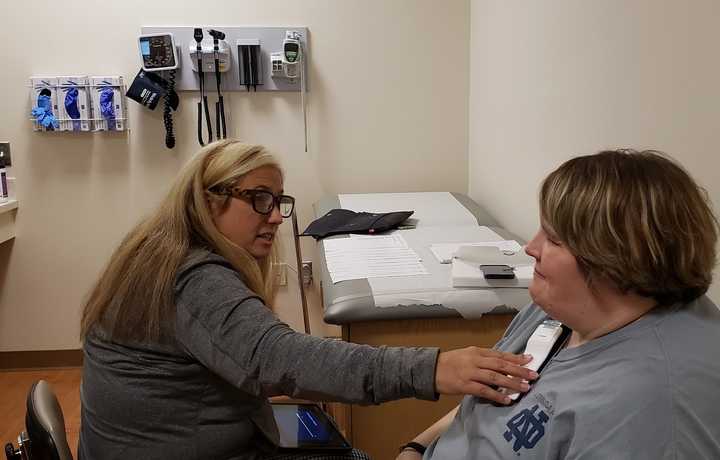Mary Rice, 42, of Toms River, began experiencing the extreme facial pain one day in January 2018.
She described it as electric shocks over her left eye, and almost anything set it off.
"Healthcare professionals talk about a 10-point scale of pain with their patients," she said. "My pain was mostly a 10+, off the scale, leaving me unable to do the most simple of tasks and preventing me from working and really, just simply, enjoying life.”
The pain was so debilitating that Rice was forced to leave her job and apply for Social Security.
But now, after a minimally invasive, deep brain stimulation (DBS) implantation procedure completed at the Hackensack Meridian Neuroscience Institute at Jersey Shore University Medical Center (JSUMC), in Neptune, in July 2023, and advanced treatment technique, Rice is able to prevent the pain from occurring through a cell phone.
Rice suffers from atypical facial pain related to Trigeminal neuralgia (TN) in the Ophthalmic Nerve v1 branch, also known as tic douloureux or facial pain. In other terms, it's a type of chronic pain disorder that involves sudden, severe facial pain that affects the trigeminal nerve, or fifth cranial nerve, which provides feeling and nerve signaling to many parts of the head and face.
TN is a type of neuropathic pain, sometimes described "as the most excruciating pain known" with an estimated 150,000 people diagnosed each year, according to the American Association of Neurological Surgeons (AANS).
In 2021, Rice's primary care physician referred her to JSUMC's new neurosurgical program, headed by Chair of Neurosurgery and Board Certified Neurosurgeon Shabbar F. Danish, M.D., FAANS. At first, the thought was that Rice had fluid "on the brain," but an MRI showed otherwise. Initially, Rice participated in a peripheral nerve stimulation trial and received a microvascular decompression procedure in September 2022. They proved ineffective.
“We develop a customized and comprehensive management plan for each patient to meet their specific needs,” Danish said. “Our goal is to minimize symptoms and optimize their ability to function, so patients can live full and content lives.”
DBS is essentially a pacemaker for the affected areas of the brain that are involved in the movement disorder. The implantation surgery involves placing a small wire or stimulating lead in the area of the brain affected. Extension cables are then routed under the skin down to the chest where the neurostimulator is implanted. When switched on, the system delivers a continual electrical stimulation, unfelt by the patient, to improve symptoms.
Clinical Neurophysiologist Eric Hargreaves, who holds a PhD, assists in guiding electrodes to their neural targets during surgery and managing the patients’ DBS systems afterward.
“I suffered from migraines since I was eight but that was nothing like this pain,” Rice said, noting she received a variety of medical treatments over the years to stop the pain.
But ultimately, none of the procedures or treatments brought pain relief. Until now.
“Now the pain has been greatly reduced," she said, "and as I continue to work with Jersey Shore’s neurological team to calibrate my system, I’m told the pain will subside even more!"
Rice is now a strong advocate for JSUMC’s program and wants other people who suffer from TN to be aware that pain relief can be found at the academic medical center. She is on the board of the Facial Pain Association - Philadelphia Chapter as co-leader and regularly attends support group meetings.
Click here to follow Daily Voice Howell-Farmingdale and receive free news updates.

